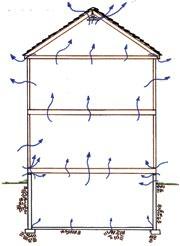Blown-in Cellulose Insulation in Hampton, VA Attic
Challenge
A Homeowner in Hampton, VA contacted us with concerns about the insulation quality in the attic of his home. This homeowner was experiencing high energy bills and his heating and cooling unit running frequently. They were also experiencing uneven temperatures in their home such as the upstairs being hotter or colder than the downstairs, or rooms at one end of the house being hotter than others. These are common symptoms of poor insulation values or thicknesses.
At their appointment, Mike discussed the homeowner’s concerns with them then did a thorough inspection of their attic. Mike noticed that the current attic insulation was discolored and looked dirty, this was likely a result of the insulation acting as a “filter” for any air passing through it from the second floor. The existing insulation was loose fiberglass, this is one of the least effective insulation materials offering an R-value of 3.2 per inch (R-value is the insulation’s resistance to heat). The loose fiberglass allows air to easily pass through it and escape into the unconditioned attic out of the home.
Attic spaces are also a leading cause of conditioned air loss, the driving factor behind this is the stack effect. Building science tells us that air is pulled into the bottom of your home through the crawl space, basement, or other openings such as doors, windows, leaky walls, or plumbing and electrical penetrations. This air is pulled up through the house and escapes through the attic. When you home leaks air, it is replaced with new unconditioned air.
Solution
After his inspection, Mike shared his findings with the homeowner. His recommendation was to remove the existing loose fiberglass, air seal and install blown cellulose insulation. We installed an R-38 of blown in insulation in this homeowner’s attic. We installed a dam made with foam board insulation around the access to ensure that the blown cellulose does not fall when the attic is accessed and to provide a clean finish. The homeowner did not opt to air seal his attic, though we strongly recommend doing so. Air sealing your attic is a crucial step in ensuring that you are properly insulating your home. Air leaks through the top plates, can lights, and other penetrations into your attic. Without air sealing, this air passes through the insulation and escapes into the unconditioned space.
At 10.5 inches, cellulose insulation offers an R-38, it takes 14 inches of blown in fiberglass to achieve the same R-value (we discuss an R-38 because this is the Building Code Requirement for Virginia). The cellulose is also a more dense material than fiberglass, allowing less air to pass through it. In addition, the brand of cellulose used by The Drying Company, Applegate Insulation, is 85 percent recycled material such as newspaper, it is fire retardant because it is manufactured with borate, a substance that deters pests.
Project Summary
Cellulose Insulation: Applegate Insulation





